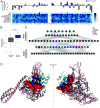Data-driven large-scale genomic analysis reveals an intricate phylogenetic and functional landscape in J-domain proteins
- PMID: 37523524
- PMCID: PMC10410713
- DOI: 10.1073/pnas.2218217120
Data-driven large-scale genomic analysis reveals an intricate phylogenetic and functional landscape in J-domain proteins
Abstract
The 70-kD heat shock protein (Hsp70) chaperone system is a central hub of the proteostasis network that helps maintain protein homeostasis in all organisms. The recruitment of Hsp70 to perform different and specific cellular functions is regulated by the J-domain protein (JDP) co-chaperone family carrying the small namesake J-domain, required to interact and drive the ATPase cycle of Hsp70s. Besides the J-domain, prokaryotic and eukaryotic JDPs display a staggering diversity in domain architecture, function, and cellular localization. Very little is known about the overall JDP family, despite their essential role in cellular proteostasis, development, and its link to a broad range of human diseases. In this work, we leverage the exponentially increasing number of JDP gene sequences identified across all kingdoms owing to the advancements in sequencing technology and provide a broad overview of the JDP repertoire. Using an automated classification scheme based on artificial neural networks (ANNs), we demonstrate that the sequences of J-domains carry sufficient discriminatory information to reliably recover the phylogeny, localization, and domain composition of the corresponding full-length JDP. By harnessing the interpretability of the ANNs, we find that many of the discriminatory sequence positions match residues that form the interaction interface between the J-domain and Hsp70. This reveals that key residues within the J-domains have coevolved with their obligatory Hsp70 partners to build chaperone circuits for specific functions in cells.
Keywords: Hsp40 co-chaperones; J-domain proteins; artificial neural networks; large-scale data analysis; protein homeostasis.
Conflict of interest statement
The authors declare no competing interest.
Figures




References
Publication types
MeSH terms
Substances
LinkOut - more resources
Full Text Sources

